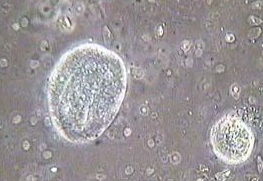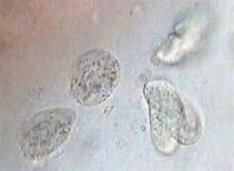Even one parasite warrants immediate action
The parasite Chilodonella is a major threat to fish health and finding even one parasite warrants immediate treatment. Chilodonella is a potentially dangerous parasite for two reasons. First, unlike many parasites, it has a wide range of temperature tolerance and outbreaks often occur at low temperatures when fish are least able to resist. Secondly, despite is relative small size it, is potentially more dangerous than Ich, because in the initial stages there are no readily visible signs of its presence.
Chilodonella |
|
 |
Chilodonella at 400x magnification (phase contrast) |
 |
Chilodonella as seen in a wet mount of a skin scrape |
|
Photos: Frank Prince-Iles |
|
Often by the time it becomes obvious that something is wrong there may already be severe tissue damage. As with other parasites there is also the risk of secondary infections resulting from lesions caused by the parasite’s feeding activity.
Identification
The clinical signs are the same as all other parasite infestations. Heavy and laboured ‘breathing’ (judged by watching operculum movements), flashing and rubbing, skin cloudiness caused by excess mucus, loss of appetite and lethargy. At a later advanced stage (which may be too late for treatment) fish often isolate themselves, sometimes near the water surface or water return. They can also exhibit extreme lethargy with long spells laying on the bottom with clamped fins.
It can be easily recognized in skin scrapes and gill biopsies from its characteristic slow gliding movements, often turning in circles.
It has a flattened shape, heart-shaped with a notched end. There are bands of cilia on the ventral (bottom) surface, just faintly visible in the photomicrograph. They measure around 30 – 80 µm in length x 20 -60 µm width. – slightly smaller than skin-dwelling Trichodina.
Treatments
Chilodonella is usually easy to treat with any proprietary parasite treatment, malachite and formalin, potassium permanganate, copper or salt baths. One treatment is usually sufficient

